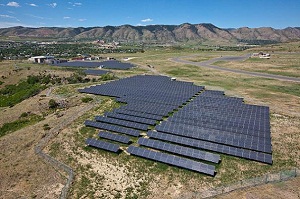Solar energy news in review
 The first week of 2011 has passed, and while the weather is cooling down, the world of solar remains hot. While the news for the solar industry was overall good, one of its ardent supporters, Rep. Gabrielle Giffords (D-Ariz.) remains in critical condition after the shooting at her “Congress on Your Corner” event. We all hope she has is able to recover and return to her role as a Representative.
The first week of 2011 has passed, and while the weather is cooling down, the world of solar remains hot. While the news for the solar industry was overall good, one of its ardent supporters, Rep. Gabrielle Giffords (D-Ariz.) remains in critical condition after the shooting at her “Congress on Your Corner” event. We all hope she has is able to recover and return to her role as a Representative.
In one interesting move, large power provider Sempra Generation sold its stake in a natural gas-fired power plant to invest in more solar and wind power. The company said that now is the right time to invest in renewables.
Kaiser Permanente became one the first health care organizations to install solar power at one of its facilities, when the solar installation at its Santa Clara facility went live last week. Another care facility, the Masonic Village at Elizabethtown, in Pennsylvania, is installing a 1.2 megawatt photovoltaic system, which will be completed February.
Last week, the University of Utah said research being done to reduce the cost of germanium-based photovoltaic cells could develop highly efficient solar cells at lower costs.
The news for large-scale commercial development was mixed last week. Department of Interior Secretary Ken Salazar signed off on a new 110 megawatt solar thermal plant in Nevada. On the other hand, two projects in California, which previously received both federal and state approval, are now facing new issues. Tessera Solar sold the 850-megawatt Calico Solar Project to K Road shortly after losing a power-purchase agreement with Southern California Edison. And the Bureau of Land Management is being sued by the California Unions for Reliable Energy, over BLM’s approval of the Genesis Solar Project.
While some of these large-scale projects are facing setbacks, other parts of the solar world are steaming ahead. Most the large solar news has been coming out of the Southwest. That may be about to change, a new Maryland renewable energy law went into effect last week that set a schedule for utilities to meet the state’s 20 percent renewable energy portfolio by 2020.
New Jersey, which is still the nation’s second-largest market for solar, behind California, made solar news last week as well with two large rooftop installations. Nobody really wants to read a green paper, but the North Jersey Media Group, which publishes numerous local papers, announced that it would install a 4.2 megawatt installation on its roof, and White Rose, Inc.’s food distribution warehouse will get a 5 megawatt photovoltaic array, thanks to Solar Power Inc.
Separate events in Oregon and Colorado should make it easier for homeowners to gain access to solar power for their homes. SolarCity became the first company in Oregon to offer homeowner residents solar leases with no down payment. In Colorado, folks in the greater Denver-metro region got access to an online, searchable solar map, which allows them to enter their address and shows them how suited their home is for solar power.
Two new reports issued last week look into the future of the solar industry in 2011 and beyond. China is assuredly one of the fastest growing countries in terms of population and its solar industry. But investors are wary of whether or not now is time to invest the market, according to The Bedford Report. A new Lux Research report looked into which countries, beyond the U.S. and Europe, will become important markets for solar in the future.
In other solar news, a law passed during the lame-duck session of Congress ensures that the Defense Department must choose U.S.-made photovoltaic modules when it adds them. And Massachusetts’ became the most recent state to start offering a solar hot water rebate program through the state’s Clean Energy Center.
Image courtesy of NREL.



